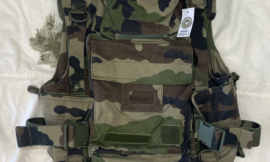The Sten gun, officially known as the Sten submachine gun, is one of the most iconic and recognizable firearms from World War II. Developed by the British during the early years of the war, the Sten was designed to be a simple, cost-effective weapon that could be produced quickly and in large numbers to arm British and Commonwealth forces.
Historical Background
The development of the Sten gun was driven by the urgent need for a reliable and easily manufacturable submachine gun after the Dunkirk evacuation in 1940. The British Army lost much of its equipment during the evacuation, and the threat of a German invasion loomed large. Existing submachine guns, like the Thompson, were expensive and difficult to produce in the quantities needed.
Major Reginald V. Shepherd and Harold J. Turpin of the Royal Small Arms Factory at Enfield (hence the name “Sten,” derived from their initials and “Enfield”) designed the weapon in 1941. The Sten’s simplicity and use of stamped metal parts made it inexpensive and quick to produce, with over four million units manufactured during its service life.
Design and Features
The Sten gun is a blowback-operated, open-bolt submachine gun. Its design prioritizes simplicity and ease of manufacture:
- Simplicity and Economy: The Sten’s design uses a minimal number of parts, many of which are stamped metal. This simplicity reduced production costs and time.
- Magazine Feed: The Sten uses a side-mounted magazine, typically holding 32 rounds of 9×19mm Parabellum ammunition. This design allows for a compact profile but is prone to reliability issues if the magazine is damaged or improperly maintained.
- Open-Bolt Operation: The Sten fires from an open bolt, which simplifies the firing mechanism and helps with cooling during sustained fire.
- Straight Blowback Mechanism: This straightforward mechanism uses the force of the expanding gases from a fired cartridge to cycle the bolt and chamber the next round.
- Ergonomic and Functional Design: The Sten’s basic design includes a tubular receiver, simple trigger mechanism, and rudimentary iron sights. Some models also feature a folding or retractable stock for easier handling and transport.
Variants
Several variants of the Sten gun were produced, each with minor modifications to improve performance and ease of production:
- Sten Mk I: The original model, featuring a wooden foregrip and a folding skeleton stock.
- Sten Mk II: The most widely produced variant, known for its simple construction and use of a removable barrel. This version was often manufactured by various subcontractors, leading to slight variations.
- Sten Mk III: A more simplified version with an integral barrel and receiver made from a single steel tube.
- Sten Mk V: An improved model introduced in 1944, featuring a wooden stock, pistol grip, and a bayonet mount, offering better ergonomics and aiming stability.
- Sten Mk VI: A suppressed version of the Mk V, designed for covert operations.
Military Use
The Sten gun saw extensive use by British and Commonwealth forces during World War II and in subsequent conflicts:
- World War II: The Sten was used in all theaters of the war, from the deserts of North Africa to the forests of Europe. It was particularly favored by airborne troops and resistance fighters due to its lightweight and compact design.
- Post-War Use: After World War II, the Sten continued to be used in various conflicts, including the Korean War, the Malayan Emergency, and by numerous insurgent and paramilitary groups worldwide.
- Resistance and Guerilla Warfare: The simplicity and ease of manufacturing the Sten made it ideal for resistance movements and guerilla warfare. Many Stens were produced in clandestine workshops under occupation conditions.
Performance
The Sten gun’s performance is characterized by its ease of use, compact size, and the ability to deliver a high volume of fire. However, it also had several drawbacks, including:
- Reliability Issues: The Sten was prone to jamming and misfires, especially if the magazines were damaged or not properly maintained.
- Accuracy: The Sten was not particularly accurate beyond short ranges, but its intended use in close-quarters combat mitigated this limitation.
- Ergonomics: While functional, the Sten’s basic design did not provide the best ergonomics, particularly in the earlier models.
Conclusion
The Sten gun remains an enduring symbol of British ingenuity and wartime necessity. Its design exemplifies the balance between simplicity, cost-effectiveness, and functionality. Despite its shortcomings, the Sten’s impact on the outcome of World War II and its legacy in post-war conflicts is significant. It stands as a testament to the ability to produce effective weaponry under the constraints of war and has earned its place in military history as one of the most important submachine guns of the 20th century.


